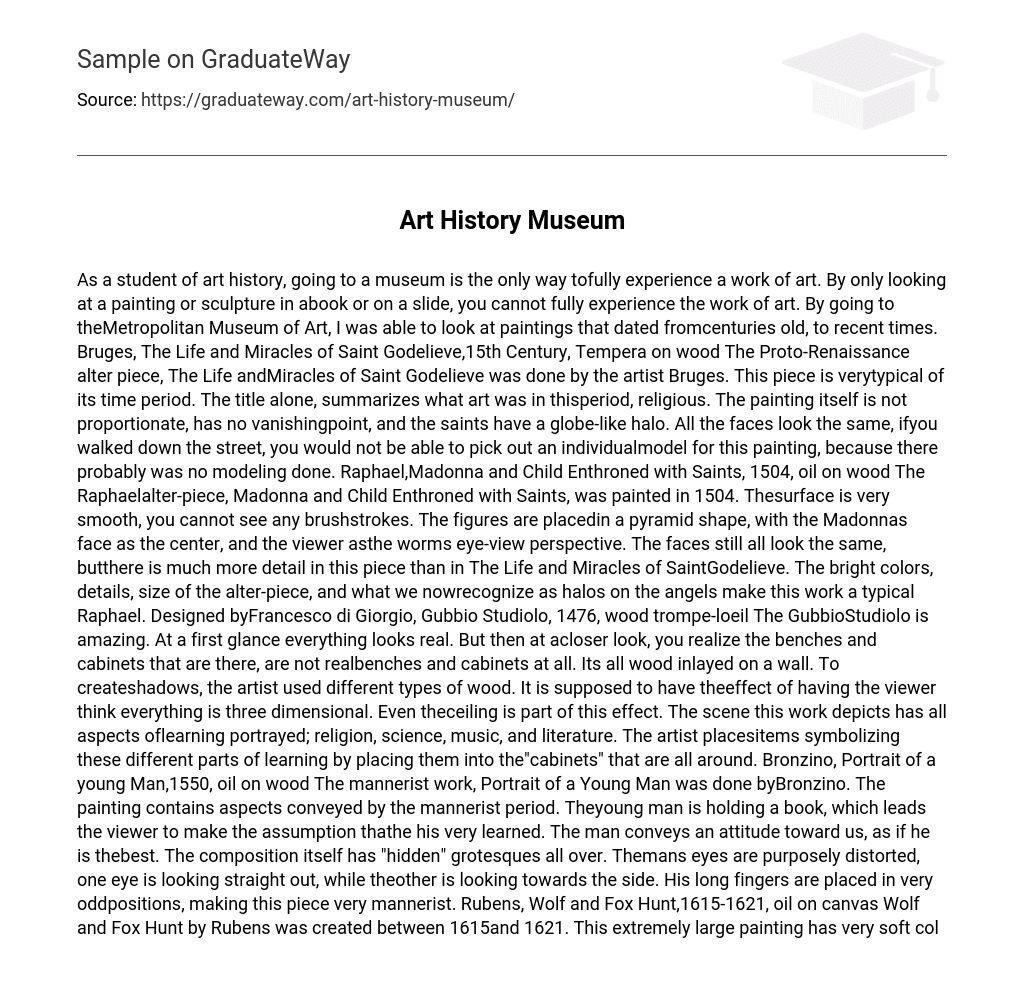As a student of art history, going to a museum is the only way tofully experience a work of art. By only looking at a painting or sculpture in abook or on a slide, you cannot fully experience the work of art. By going to theMetropolitan Museum of Art, I was able to look at paintings that dated fromcenturies old, to recent times. Bruges, The Life and Miracles of Saint Godelieve,15th Century, Tempera on wood The Proto-Renaissance alter piece, The Life andMiracles of Saint Godelieve was done by the artist Bruges.
This piece is verytypical of its time period. The title alone, summarizes what art was in thisperiod, religious. The painting itself is not proportionate, has no vanishingpoint, and the saints have a globe-like halo. All the faces look the same, ifyou walked down the street, you would not be able to pick out an individualmodel for this painting, because there probably was no modeling done. Raphael,Madonna and Child Enthroned with Saints, 1504, oil on wood The Raphaelalter-piece, Madonna and Child Enthroned with Saints, was painted in 1504.
Thesurface is very smooth, you cannot see any brushstrokes. The figures are placedin a pyramid shape, with the Madonnas face as the center, and the viewer asthe worms eye-view perspective. The faces still all look the same, butthere is much more detail in this piece than in The Life and Miracles of SaintGodelieve. The bright colors, details, size of the alter-piece, and what we nowrecognize as halos on the angels make this work a typical Raphael. Designed byFrancesco di Giorgio, Gubbio Studiolo, 1476, wood trompe-loeil The GubbioStudiolo is amazing. At a first glance everything looks real.
But then at acloser look, you realize the benches and cabinets that are there, are not realbenches and cabinets at all. Its all wood inlayed on a wall. To createshadows, the artist used different types of wood. It is supposed to have theeffect of having the viewer think everything is three dimensional.
Even theceiling is part of this effect. The scene this work depicts has all aspects oflearning portrayed; religion, science, music, and literature. The artist placesitems symbolizing these different parts of learning by placing them into the”cabinets” that are all around. Bronzino, Portrait of a young Man,1550, oil on wood The mannerist work, Portrait of a Young Man was done byBronzino.
The painting contains aspects conveyed by the mannerist period. Theyoung man is holding a book, which leads the viewer to make the assumption thathe his very learned. The man conveys an attitude toward us, as if he is thebest. The composition itself has “hidden” grotesques all over.
Themans eyes are purposely distorted, one eye is looking straight out, while theother is looking towards the side. His long fingers are placed in very oddpositions, making this piece very mannerist. Rubens, Wolf and Fox Hunt,1615-1621, oil on canvas Wolf and Fox Hunt by Rubens was created between 1615and 1621. This extremely large painting has very soft colors.
The painting islight and airy. To look at it, is like looking at a real scene through an earlymorning mist. This mood is created by the soft brushstrokes that are used. Forexample, in the horses tail, you can see all the brushstrokes, which givesthe hair depth. Rembrandt, Self-Portrait, 1660, oil on canvas RembrandtsSelf-Portrait, done in 1660, creates a dark, unpleasant mood. Rembrandt looksworn out, tired, and very unhappy.
All of his paintings in the museum portraythis darkness. There is one light source that casts a gloomy shadow overeverything, which in his Self-Portrait, tells the viewer, that at this point inhis life, he was very unhappy. Rembrandt does not enhance his features, butinstead, makes them worse. Boucher, The Interrupted Sleep, 1750, oil on canvasThe feminism, and almost gaudiness of the Rococo period is conveyed through TheInterrupted Sleep. This painting is very small in size like many of thepaintings done during this time. The composition itself is very sensual, withthe soft pastel colors and the soft, pink bodies of the woman.
The use of thedogs show the richness that ran through this period in history. Lepage, Joan ofArc, 1880, oil on canvas The 19th century painting Joan of Arc was painted byLepage. What makes this my favorite 19th century painting is the realness ofJoan of Arc. It looks as if the artist took a snap shot of the model, enlargedit and placed it onto a painted background. Also, the size of this painting isunbelievable. It is disputed as to which period Joan of Arc belongs to.
Some sayit is part of the Romantic movement and some say it is part of the Realistmovement, and still, others claim it is part of both movements. GeorgiaOKeeffe, Gray Line with Lavender and Yellow, 1923, oil on canvas The 20thcentury work, Gray Line with Lavender and Yellow by Georgia OKeeffe isnothing like what has been done before it. There is no subject matter, excepthow the different colors are used. This painting is a picture of nothing. Theartist uses gray, teal, lavender, pink, yellow, and blue to portray somethingthat is not real. She wants the viewer to use the mind and imagination to makeup their own composition.
Gray Line with Lavender and Yellow helped break theidea that art had to be a painting of something. To fully experience a work ofart, you must go see it in person. Studying them in class should not be the onlytime you see them. To be in a room that is filled with paintings by Raphael andRembrandt is quite an experience that everyone at least once in their lifeshould have a chance to do.
Arts and Painting





